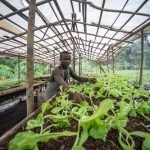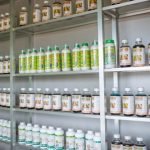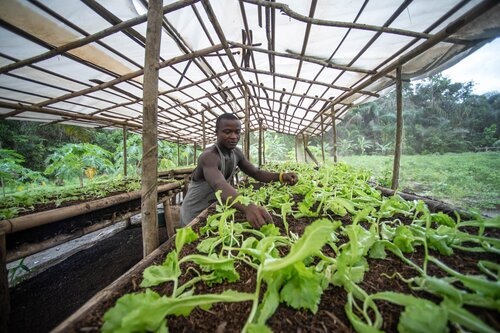
When Good Intentions Aren’t Enough: How Free Inputs Harm Farmers
January 9, 2024
Ruptured global supply chains caused temporary shortages in Liberia
January 9, 2024Carefully designed subsidy programs that utilize local markets can provide important assistance for farmers who are affected by crisis and better address long-term seed and inputs security.
Aid programs and governments often choose to distribute agricultural inputs, like seeds or fertilizers, directly to farmers free of charge in times of crisis or disaster. Typically, this is done in the hope that free inputs will provide an immediate boost for farmers while contributing to improved agricultural productivity over time.
But, direct distribution of inputs free of charge may actually be more harmful than helpful – perhaps counter-intuitively. Evidence suggests that the practice:
- Undermines private sector investment in agricultural markets by displacing private sector seed, fertilizer, and agro-chemical channels that are the main sources of goods and advisory for farmers. Free distributions by aid programs and governments make it cost-prohibitive and unattractive for agro-dealers and distributors to compete with these programs to sell their inputs in rural areas. Further, depressed local markets are unable and disincentivized to offer more and better products and services to farmers due to limited revenue caused by dwindling or unpredictable sales.
- Promotes aid dependency among farmers rather than self-sufficiency and growth. Direct and free input giveaways may cause farmers to rely heavily on the agency that provides the products. Rather than purchase inputs for production, farmers who have received inputs or who expect to receive inputs will wait to farm in anticipation of receiving them once more. This perpetuates the cycle of dependency – making them less likely to be any more self-sufficient at the end of the “hand-out” program than they were at the beginning.
- Costs more than alternative approaches, thus limiting the volume and range of support available for farmers. The Food Security Policy Innovation Lab (FSP) found that in 2013, 10 African countries had spent nearly $1 billion per annum on input subsidy programs, roughly 29 percent of their public spending on agriculture. Such programs unintentionally absorb public resources from other much needed investments, such as research and development and infrastructure – which are more likely to boost agricultural development.
However, a carefully designed subsidy program – particularly one that utilizes local markets – can provide important assistance for farmers who are affected by crisis or cannot afford inputs. These programs typically leverage existing market actors (informal as well as formal) to better address long-term seed and inputs security for farmers than those that deliver inputs directly and for one or a few seasons.
How are ‘smart subsidy’ initiatives designed?
The following two projects from Uganda and Zambia offer examples for how to utilize markets, instead of direct delivery, to boost farmer productivity through the use of subsidies:
Case Study Uganda: Agro-Inputs Vouchers Offered to Farmers Via Certified Agro-Dealers
In 2018, the Ugandan government signed a Memorandum of Understanding (MoU) with district governments to stop the distribution of free agro-inputs to farmers. The government had previously distributed free inputs with the purpose of boosting farming in the country. However, following decades of free inputs distribution coupled with minimal overall agricultural development, the government decided to change course. According to Beatriace Byarugaba, Uganda’s Minister of Agriculture, “farmers waste free things, thereby necessitating government to build a sustainable model that will make farmers invest in agriculture as a business.”
With this objective, the Ugandan government launched a pilot project with support from the World Bank that is expected to benefit 450,000 households cultivating maize, beans, rice, cassava and coffee.
How? The project employs an e-voucher system in which registered farmers can access farming inputs via an online system which connects farmers to pre-qualified, certified agro-dealers. Agro-inputs are partially subsidized for those who qualify.
The project uses a graduated subsidy approach: In the first season, the farmer pays 33% of the cost of inputs while the government contributes 67%. In the second season, each party provides 50% of the cost. In the third, the farmer pays 67% while government contributes 33%. Further, agronomic training is offered through agro-dealers and extension services throughout.
Case Study Zambia: Vouchers Improve Subsidy Effectiveness and Attract Private Sector Investment
The Zambian government’s Farmer Input Support Program (FISP) distributed inorganic fertilizer and seeds directly to farmers with the objective of increasing farmer productivity and food security. However, the program which accounted for nearly 40% of the annual national agricultural sector budget had little impact on productivity and farmer performance. Moreover, the government’s involvement in the distribution of inputs seemed to stifle private sector participation and investment while leading to misuse of funds – ultimately harming agricultural development rather than helping it.
In 2015, Zambia’s Ministry of Agriculture, with support from a USAID project, developed an alternative approach that also utilized an e-voucher. Targeted again to qualifying farmers, the voucher used a mobile delivery and tracking system to ensure that vouchers and products ended up in the hands of the right farmers. Further, the voucher secured subsidized inputs via local agro-dealers.
Overall, the MoA concluded that the voucher system improved subsidy targeting and budget efficiency. It also better met the needs of farmers by diversifying the types of products available to them. Further, the approach also made the input sector more attractive to private investors.
Could similar voucher programs work in Liberia?
Smart subsidies can meet critical needs in the short-term while contributing to the health of Liberia’s agricultural system over the long-term. Carefully designed voucher programs that leverage markets may be one answer. These programs do offer a compelling, efficient alternative to direct delivery initiatives. Benefits include offering farmers the freedom to decide which inputs would be best for their farming needs and markets. Further, if designed to integrate agro-dealers, the voucher approach would also likely strengthen relationships between farmers and agro-dealers while encouraging agro-dealers and distributors to invest more to meet farmer needs over the long-term. Overall, a voucher program would also be much more cost-effective – eliminating distribution logistics costs.
Interested in more information on ‘smart subsidy’ design and use?
Check out these resources:
- What Policies Boost Farmer Use of Improved Inputs?
- Bringing Seeds to Market: A study of partnerships commercializing seed technologies in the smallholder farmer market
- Policy perspectives on the role of government in the distribution of agricultural inputs to farmers: Lessons from Zimbabwe
About GROW Liberia
GROW is an agri-business and investment advisory program that partners with businesses, investors, associations, and government agencies to accelerate inclusive economic returns within high growth industries in Liberia. GROW is supporting public and private partners and markets to respond to the COVID-19 emergency. Learn more about our research, advisory, and support here.




